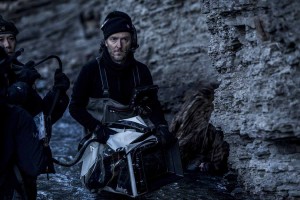
The DP won two consecutive Academy Awards for best cinematography, last year for Birdman and the year before for Gravity. And earlier this week he was one of five DPs nominated by the American Society of Cinematographers for best lensing of a feature film for his work on The Revenant. On the film, Lubezki reteamed with director Alejandro González Iñárritu, who last year won three Academy Awards for helming, scripting and producing Birdman, the 2015 best picture.
The Revenant is set in the forbidding frontier wilderness of 1820s America and is based on the true story of legendary explorer Hugh Glass, played by DiCaprio. While on an expedition into the uncharted wild, he is attacked by an enormous bear, then abandoned by members of his own hunting team. Near death, Glass clings to life and driven by sheer willpower, he travels on a grueling 200-mile journey through untamed country, seeking the man who betrayed him, John Fitzgerald, played by Tom Hardy.
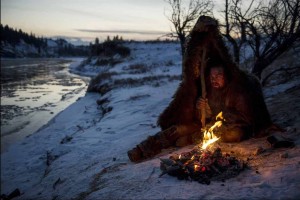
Lubezki recently talked with Below the Line about the tremendous requirements of filming the movie. “Doing Revenant pushed me to the very limit. Absolutely every day the situation was among the most difficult I have ever been in,” said the cinematographer. “It was lucky that I did this movie at this point in my career, because I couldn’t have done it without my past experience.” He had already employed only natural lighting on a number of films over the past dozen years. “A big part of Y Tu Mamá También, a big part of Children of Men and all of The Tree of Life was shot using that technique,” he said.
The survival saga is launched with a jolt. An enraged mother grizzly bear charges and mauls DiCaprio. The bear is so convincingly true-to-life that the audience can’t help but believe that the brutal mauling is really happening, though the scene could not have been pulled off without the application of some of the most skilled and sophisticated computer graphics work that’s ever been done.
“The bear was one of the most difficult scenes in the movie,”said Lubezki. “It took months of preparation and rehearsal, in order to understand the logistics of how it would work and how to shoot it.” He refused to reveal much more. “If I tell you, it’s like a magician giving away the trick.” But he did talk about the enormity of what Di Caprio had to do physically to be pummeled and chewed on by what was in fact a CGI bear. “When Leo was shaken by the bear, he had to have the strength of an Olympic athlete to go through the contortions,” said the DP.
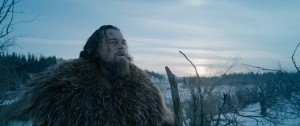 One of the decisions Iñárritu and Lubezki made at the outset was to shoot using only natural light, relying on the sun and working with the light of nature in creative ways. The idea was not just to do without any artificial light – modern camera lighting was totally out – but to only use what was available in the 1820s wilderness days.
One of the decisions Iñárritu and Lubezki made at the outset was to shoot using only natural light, relying on the sun and working with the light of nature in creative ways. The idea was not just to do without any artificial light – modern camera lighting was totally out – but to only use what was available in the 1820s wilderness days.
“Even for the handful of night scenes we only used real sources, like camp fires and torches,” said the DP. “When the story took place it was 1823, and they didn’t yet have kerosene, so we couldn’t use any kerosene lamps because they didn’t exist. Alejandro insisted on being historically accurate in this detail along with everything in The Revenant.”
“Using natural light doesn’t mean you just arrive and shoot,” he noted. “In order to have continuity, you have to analyze the location well in advance. You have to know perfectly just where you are shooting. You have to know how the sun moves. If it goes behind the mountain, you have to assess that, and also what happens when clouds arrive,” he added. “You have to go there and stay there the whole day. But it’s not so much a lot of waiting, but a lot of planning ahead. So when the time is right, and you get the colors you want and the atmosphere and mood is right, you attack.”
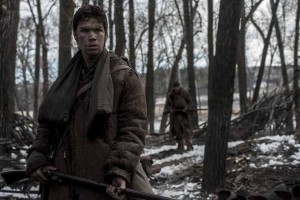 “There’s also so much complexity,” he said. At one point in the movie, Hardy is sitting in a tree and confronts Leo. “In that scene alone there are several different lighting circumstances,” said the cinematographer. “The shot starts with the sun out, then goes into clouds, then the sun comes back again and then very heavy clouds arrive. All of that is portrayed in the moment. The audience is probably not aware of it, but I think subconsciously they feel immersed in that real world.”
“There’s also so much complexity,” he said. At one point in the movie, Hardy is sitting in a tree and confronts Leo. “In that scene alone there are several different lighting circumstances,” said the cinematographer. “The shot starts with the sun out, then goes into clouds, then the sun comes back again and then very heavy clouds arrive. All of that is portrayed in the moment. The audience is probably not aware of it, but I think subconsciously they feel immersed in that real world.”
As is his usual practice, Lubezki was not just the director of photography but also was the camera operator. He shot with the cutting-edge ARRI Alexa 65, a brand new large-format digital camera. He used a range of wide lenses, from 12mm to 21mm, which allowed for great depth of field. The flexibility of the system lent itself to camera movements that go from extreme close ups to panoramas. The sweeping distance shots are employed at times to show DiCaprio from a great distance, struggling through long stretches covered with deep snow. The camera crew employed telescoping cranes, Steadicams and hand-held cameras. In one memorable scene, utilizing all the camera equipment available, DiCaprio is filmed as he’s swept down a rushing river and then he goes over a big waterfall and survives. This is not some Butch Cassidy and the Sundance Kid embellishment but was what Glass somehow endured and survived.
Photographing day after day in lots of snow wasn’t easy. “Sometimes there were areas cleared so I could move around,” he noted. “I also had snowshoes, and wore six or even eight layers of clothing all the time because it was so cold, which of course made it harder to operate the camera.”
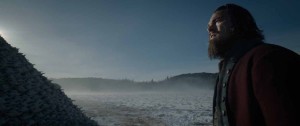 A lot of the handheld work was done just above snow level. “When Leo is on the ground crawling, the camera has to be inches from the ground as well,” he said. “It was very hard on my back and my feet and very uncomfortable because the camera was so heavy. But almost every shot was aimed at capturing Leo and the environment. It determined what lens we used, how the movie was cut, the music and sound effects. For Alejandro, it was always about connecting the environment to the character.
A lot of the handheld work was done just above snow level. “When Leo is on the ground crawling, the camera has to be inches from the ground as well,” he said. “It was very hard on my back and my feet and very uncomfortable because the camera was so heavy. But almost every shot was aimed at capturing Leo and the environment. It determined what lens we used, how the movie was cut, the music and sound effects. For Alejandro, it was always about connecting the environment to the character.
“We also wanted the audience to feel the experience that environment,” he added, “how hard it is, how harsh it is and also how beautiful. If you are making an allegory of life, you want to show the contradictions of life. You want to show death and birth, beauty and horror.”
Lubezki is famous for doing long single-shot takes, a prominent feature of Birdman. For that film the DP operated the camera for as long as 12 minutes without stopping. In The Revenant, the takes are also impressively extended, especially given the shooting environment, though nowhere near the length or the extent of those in Birdman.
One scene near the very end of the film really stands out. Di Caprio and Hardy have a no-holds-barred fight that goes on for several minutes, an extraordinary case of physical acting without taking a break, of overwhelming stamina and commitment. In other movies, big fight scenes usually are created by putting together a montage of parts from a number of takes.
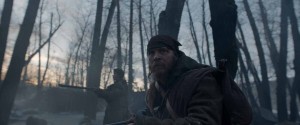 “It seemed like one take, but it was really two takes that the editor almost invisibly stitched together,” Lubezki confessed. “We didn’t just do it to show off. We wanted viewers to experience the fight in real time without cutting, so it would seem more random, more brutal and more naturalistic.”
“It seemed like one take, but it was really two takes that the editor almost invisibly stitched together,” Lubezki confessed. “We didn’t just do it to show off. We wanted viewers to experience the fight in real time without cutting, so it would seem more random, more brutal and more naturalistic.”
The brutality was not designed to sensationalize the film, said the cinematographer. “It was very important to Alejandro and to me not to glamorize violence,” he asserted. “A lot of movies these days do glamorize violence, which creates callousness and desensitizes people – and even invites people to become violent,” he said. “We wanted to make the audience see the horror of the violence.”
What was it like for Lubezki to do an encore with Iñárritu on The Revenant, which was so much more demanding than even the pyrotechnic virtuosity required of him on Birdman. “Alejandro always requests things that are so hard,” said the DP. “But that’s because he is one of the greatest directors alive. He understands the tools of filmmaking and the language of filmmaking like almost nobody else. And he has a tremendous appetite for perfection, and he also wants perfection that looks imperfect.”





